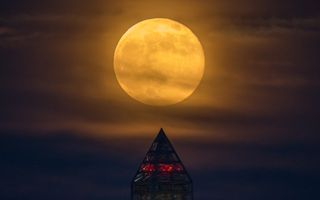See the 'Super Worm Moon' Rise with the Spring Equinox Today!
March's full moon is a special one. Not only is it a slightly larger than the usual "supermoon," but it also will mark the beginning of spring in the Northern Hemisphere and fall in the Southern Hemisphere.
The exact moment the “Super Worm Moon” turns full is Wednesday (March 20) at 9:43 p.m. EDT (0143 GMT on March 21), just 4 hours after the vernal equinox. That's when day and night on Earth are the same length, signaling the changing of the seasons.
The full moon will also happen just one day after it reaches its closest point to Earth in its elliptical or oval-shaped orbit, making it a supermoon since it appears a little larger than the typical full moon. (But at only 10 percent larger than usual, don't expect to see a big difference.)
Related: How the 'Supermoon' Looks (Infographic)

Luckily for sky observers, the moon is very easy to spot – even if you are in an area with a lot of lights. It will be visible in the constellation Virgo. The moon will rise about 7 p.m. local time on Wednesday and remain visible through the night, setting around 7:30 a.m. on Thursday (March 21), according to the U.S. Naval Observatory.
There's no need to use fancy equipment – the moon is visible with your bare eyes – but if you have binoculars or a telescope, you might be able to pick out some features on the surface. However, it's easier to spot craters and mountains when the moon is in partial shadow and shadows around these features are visible on the surface.
Super Worm Moon webcasts
If it's cloudy or too cold to go outside, you're also covered with virtual webcasts.
Get the Space.com Newsletter
Breaking space news, the latest updates on rocket launches, skywatching events and more!
The Virtual Telescope Project will host the supermoon rising above the famous monuments of Rome starting on Wednesday at 12:45 p.m. EDT (1645 GMT). The event is run in conjunction with the Dark Skies for All project of the International Astronomical Union, an initiative to promote awareness about light pollution and advocate for solutions to keep the sky dark for astronomy. The full broadcast will run at https://www.virtualtelescope.eu/webtv/
Slooh will also broadcast live coverage on Wednesday starting at 2 p.m. EDT (1800 GMT). Slooh's resident storyteller, Helen Avery, will do a broadcast from Stonehenge — a famous World Heritage Site featuring stone pillars, and a traditional gathering spot for the equinox. Also on the show will be astrophotographer Mike Shaw, as well as Slooh hosts Paul Cox and Paige Godfrey.
You can watch the Slooh webcast live here on Space.com.It will also stream live on Slooh.com and Slooh's Facebook page.
Editor's note: If you capture an amazing photo or video of the Super Worm Equinox Moon and would like to share it with Space.com for a story or a gallery, send images and comments to spacephotos@space.com.
- Full Moon Names (and More) for 2019
- Supermoon Secrets: 7 Surprising Big Moon Facts
- Best Night Sky Events of March 2019 (Stargazing Maps)
Follow Elizabeth Howell on Twitter @howellspace. Follow us on Twitter @Spacedotcom and on Facebook.
Join our Space Forums to keep talking space on the latest missions, night sky and more! And if you have a news tip, correction or comment, let us know at: community@space.com.

Elizabeth Howell (she/her), Ph.D., is a staff writer in the spaceflight channel since 2022 covering diversity, education and gaming as well. She was contributing writer for Space.com for 10 years before joining full-time. Elizabeth's reporting includes multiple exclusives with the White House and Office of the Vice-President of the United States, an exclusive conversation with aspiring space tourist (and NSYNC bassist) Lance Bass, speaking several times with the International Space Station, witnessing five human spaceflight launches on two continents, flying parabolic, working inside a spacesuit, and participating in a simulated Mars mission. Her latest book, "Why Am I Taller?", is co-written with astronaut Dave Williams. Elizabeth holds a Ph.D. and M.Sc. in Space Studies from the University of North Dakota, a Bachelor of Journalism from Canada's Carleton University and a Bachelor of History from Canada's Athabasca University. Elizabeth is also a post-secondary instructor in communications and science at several institutions since 2015; her experience includes developing and teaching an astronomy course at Canada's Algonquin College (with Indigenous content as well) to more than 1,000 students since 2020. Elizabeth first got interested in space after watching the movie Apollo 13 in 1996, and still wants to be an astronaut someday. Mastodon: https://qoto.org/@howellspace

